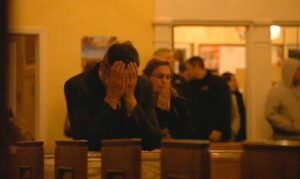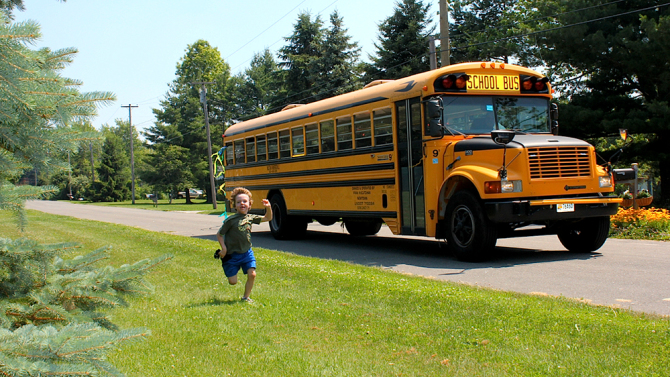Newtown (Snyder, 2016)
When by the ruins oft I past
My sorrowing eyes aside did cast
And here and there the places spy
Where oft I sate and long did lie.
–Anne Bradstreet, “Verses upon the Burning of our House, July 10th, 1666”
Puritan poet Anne Bradstreet may seem a strange voice to hear when watching Kim A. Snyder’s uncompromising documentation of the emotional consequences of the mass shooting at Sandy Hook Elementary School. But her poetry kept running through my head, explaining why a parent might have to return to the site where his child was murdered or why an audience may have to look at the thing it is most afraid to face. We may think there is something masochistic in looking, but the truth is that we fear the numbness more than the pain.
The voices in Newtown may invoke God less frequently than our Puritan ancestor, but their questions are no less fundamental, the impact of tragedy on their view of the world no less faith-shattering. Sandy Hook is an event that not only shapes their lives, but their sense of history. “Things either happened before 12/14 or after 12/14,” says one mourner. A father says he used to find beauty in the “chaos” of the universe but now wonders if he ever will again.
“Now the chaos has hurt me.”
My own life was impacted by gun violence at an early age, and my teen memories include fleeting but vivid impressions of support group meetings for parents of murdered children. I’ve seen pain this primal up close before. I thought I was prepared to see it again.
I wasn’t.
 Elements of the stories the families told were familiar, and I knew their affect from the inside out. But it’s never the common elements of these stories that get to you–it’s the personal, authenticating details. The rising terror that you are forgetting a loved one’s face, voice, and mannerisms I could deal with. The hoarding of a bicycle helmet with a few locks of hair is what made me lose it. The solicitousness of family members for one another’s grief–the fear to show one’s own pain lest it add to the impossible burden felt by those already bearing too much–brought back fresh tears from places I had long thought healed. The particular memories of particular children, the things that distinguished one victim from another and each from the statistical anonymity that allows us to depersonalize them and live with ourselves…those were the things that no amount of personal experience can steel you for.
Elements of the stories the families told were familiar, and I knew their affect from the inside out. But it’s never the common elements of these stories that get to you–it’s the personal, authenticating details. The rising terror that you are forgetting a loved one’s face, voice, and mannerisms I could deal with. The hoarding of a bicycle helmet with a few locks of hair is what made me lose it. The solicitousness of family members for one another’s grief–the fear to show one’s own pain lest it add to the impossible burden felt by those already bearing too much–brought back fresh tears from places I had long thought healed. The particular memories of particular children, the things that distinguished one victim from another and each from the statistical anonymity that allows us to depersonalize them and live with ourselves…those were the things that no amount of personal experience can steel you for.
Snyder shoots many of the interviews with her subjects facing straight at the camera, not in 3/4 profile. In the best of circumstances, such a posture creates an openness and intimacy that is uncomfortable. When the person we are looking straight in the eyes is feeling something that makes us uncomfortable, their gaze can be almost too much.
Even so, the director opined at the SXSW Film Festival that she hoped viewers would share with others that there was some sort of catharsis, something uplifting as well as terrible.
There is, of course, though we as a people may yet be too angry at our politicians and policy makers who depend upon our resiliency and the inevitability of another tragedy to distract our attention to want to admit it. The way victims of trauma take care of one another is what gives me hope for the human race. A boy marks not just his own growth on the frame of the door but the imaginary growth of a brother who will never be taller than he was on that fateful day. The parent of a survivor collects information from his son so that other parents–when they are ready–can know the answers to questions that are as yet too painful to ask. A paramedic writes a parent. A parent hugs a police officer. These, too, evoke memories of random acts of kindness, of strangers rising to unthinkable heights of charity and compassion.
How many times can a heart be broken before it can’t be healed?
In the wake of such tragedies there are calls for actions and subsequent, predictable, claims that such calls politicize these tragedies. Politicize? Abraham Lincoln once suggested the Civil War was God’s scourge for the evils of slavery. Perhaps we really don’t love our children more than our guns. Certainly you are free to argue that the Second Amendment or some abstract political principal is important enough that the Sandy Hooks of the world are an acceptable price to pay to preserve it.
Just be sure you look the Americans of Newtown square in the face when you make that argument.
And don’t you dare look away.


2 Replies to “Newtown (Snyder, 2016)”